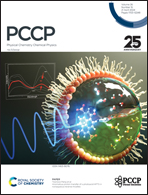A density functional study of the photocatalytic degradation of polycaprolactone by the decatungstate anion in acetonitrile solution†
Abstract
A recent experimental study has reported that decatungstate [W10O32]4− can degrade various polyesters in the presence of light and molecular oxygen [Li et al., Nanoscale, 2023, 15, 15038]. We apply density functional theory to the photocatalyst–polycaprolactone model complex in acetonitrile solution and elucidate the degradation mechanisms and catalytic cycle. We consider hydrogen atom transfer (HAT) and single electron transfer (SET) mechanisms. The potential energy profiles show that the former proceeds exergonically in a single step but that the latter involves a subsequent proton transfer and finally yields HAT products as well. Oxygenated polymer species can regain the transferred hydrogen and regenerate the reduced photocatalyst. We propose a photocatalytic cycle that realizes both the photocatalyst regeneration and the polymer degradation.



 Please wait while we load your content...
Please wait while we load your content...